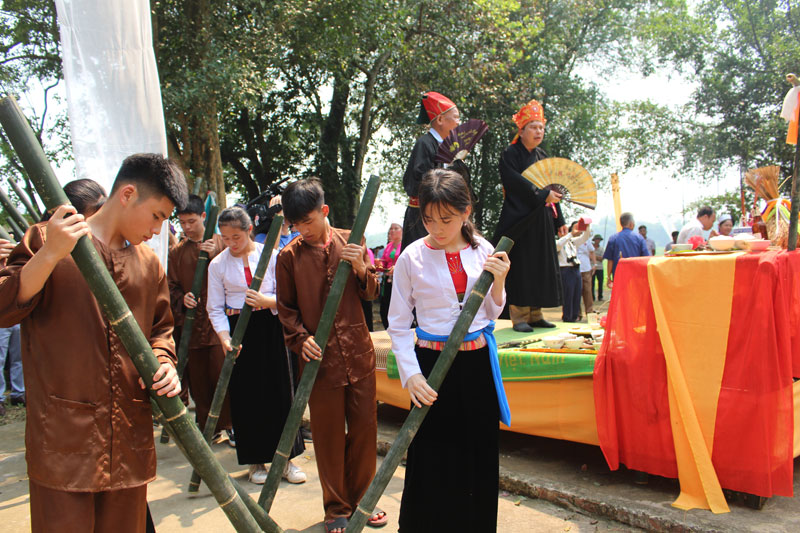
(HBO) - The People’s Committee of Lac Son district, the northern mountainous province of Hoa Binh, has held a ceremony to receive a certificate recognising the festival at Truong Kha temple, in Lien Vu commune, as a provincial cultural and historical relic site, and reenact the festival. The reenactment of the festival aims to satisfy spiritual and cultural demands of local people and contribute to preserving and upholding cultural values of the festival.
 A ritual
at the Truong Kha temple festival to pray for favourable weather conditions and
bumper crops.
A ritual
at the Truong Kha temple festival to pray for favourable weather conditions and
bumper crops.
The
Truong Kha temple in Chieng hamlet, Lien Vu commune was built in the 15th
century. It was restored in 1997 and rebuilt in 2013 by local people, using capital
mobilised from individuals and organisations.
The
elderly in the commune said the temple is dedicated to three Kun Dol Gods who
protect crops of the Muong ethnic minority group, and are worshipped by locals
in the ancient Voi-Trao area as tutelary gods.
Legend
has it that long time ago, the locality was hit by a drought that made the water
level of Buoi River shrink to a puddle in its bottom
located in Khoang Kha. The drought chapped fields and hampered rice growth. Muong
people suffered hunger and most of them had to leave their home to earn their
daily bread. At that time, the ancestor of Bui Van Xuom in Muong Trao could not
go because of his dog’s disobedience. One night when he was hesitating over
whether to leave or not, he heard sounds made by a small bird from an egg-plant
under which the dog often lay down. In the next morning, he found that the rice
fields were ripe, and asked other families in the hamlet to harvest.
Recalling
the bird sounds, he considered them a good signal from the three Kun Dol Gods. He
sacrificed a white buffalo as an offering to the Gods to pray for rain. Three
days later, the rain finally came. To show their gratitude towards the Gods,
local people built a temple to worship them and honoured them as tutelary Gods.
Since
then, local Muong people opened a festival at the temple on the 15th day of the
third lunar month triennially to pray for rain. This is an important religious
and cultural event, drawing the participation of all residents in the ancient
Voi-Trao area. It features various rituals, including the procession of the
Gods, buffalo sacrifice, rain praying and fishing.
It
also includes traditional games of Muong people like wrestling, swimming,
diving and rowing, along with other sport and cultural activities.
Through
these rituals and games, festival-goers show their gratitude and respect to the
Gods.
The
re-enactment aims to satisfy cultural and spiritual demands of people in Lac
Son district and Lien Vu commune in particular, contributing to preserving and
upholding heritage values in the locality./.
With an increasingly vibrant and widespread emulation movement aimed at building cultured residential areas and cultured families, Yen Thuy District has been making steady progress toward improving both the material and spiritual well-being of its people, while fostering a civilized, prosperous, beautiful, and progressive community.
Once lacking recreational spaces and community facilities, Residential Group 2 in Quynh Lam Ward (Hoa Binh City) has recently received attention for the construction of a new, spacious, and fully equipped cultural house. The project followed the model of state support combined with public contributions in both labor and funding.
The "All people unite to build cultural life" movement, which has been effectively integrated with Kim Boi district’s socio-economic development goals, is fostering a lively spirit of emulation across local residential areas, hamlets, villages, public agencies, and enterprises. In addition, through the initiative, traditional cultural values are being preserved and promoted, while community solidarity and mutual support in poverty reduction and economic development are being strengthened.
A working delegation of the Hoa Binh provincial People’s Committee led by its Permanent Vice Chairman Nguyen Van Toan on June 11 inspected the progress of a project to build the Mo Muong Cultural Heritage Conservation Space linked to tourism services in Hop Phong commune, Cao Phong district.
Born and growing in the heroic land of Muong Dong, Dinh Thi Kieu Dung, a resident in Bo town of Kim Boi district, in her childhood was nurtured by the sweet lullabies of her grandmother and mother. These melodies deeply imprinted on her soul, becoming an inseparable part of her love for her ethnic group's culture. For over 20 years, this love for her hometown has driven Dung to research, collect, and pass down the cultural values of the Muong people to future generations.
In the final days of May, the Ethnic Art Troupe of Hoa Binh Province organized performances to serve the people in remote, mountainous, and particularly disadvantaged areas within the province. These were not just ordinary artistic shows, but they were the meaningful journeys aimed at spreading cultural values, enhancing the spiritual life of the people and contributing to the preservation of ethnic minority cultural identities.



 A ritual
at the Truong Kha temple festival to pray for favourable weather conditions and
bumper crops.
A ritual
at the Truong Kha temple festival to pray for favourable weather conditions and
bumper crops.